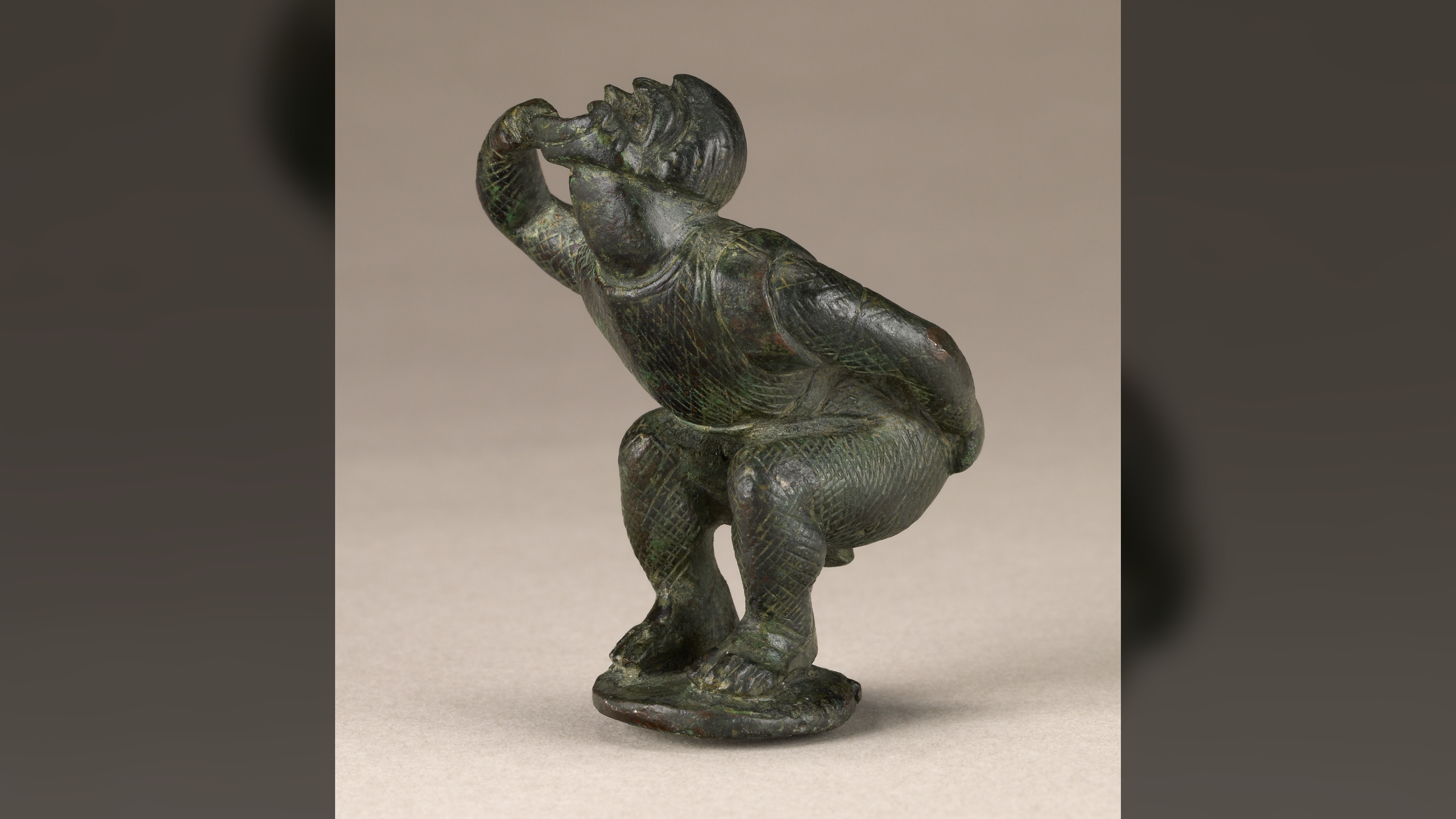By Kristina Killgrove
Copyright livescience

Skip to main content
Close main menu
Live Science
Sign up to our newsletter
View Profile
Search Live Science
Planet Earth
Archaeology
Physics & Math
Human Behavior
Science news
Life’s Little Mysteries
Science quizzes
Newsletters
Story archive
Gaia maps 44 million stars
Galilee corn hoard dates to last Jewish rebellion
Why breath stinks after brushing teeth
It’s too late to stop AI, readers say
Did ancient Egyptians booby-trap pyramids?
Don’t miss these
1,900-year-old oil lamp that provided ‘light in the journey to the afterlife’ found in Roman cemetery in the Netherlands
What did ancient Rome smell like? BO, rotting corpses and raw sewage for starters …
Roman dodecahedron: A mysterious 12-sided object that has baffled archaeologists for centuries
Archaeology
Pazuzu figurine: An ancient statue of the Mesopotamian ‘demon’ god who inspired ‘The Exorcist’
Archaeology
Vounous Bowl: A 4,000-year-old basin holding 4 miniature cows and 18 people — that was buried for mysterious reasons in a Bronze Age tomb in Cyprus
Archaeology
Penguin Vessel: 1,600-year-old Nazca depiction of a cold-water Humboldt penguin that lives in tropical Peru
1,900-year-old ‘treasure’ found in Roman-era family’s scorched house in Romania
Ancient Egyptians
3,300-year-old ancient Egyptian whistle was likely used by police officer tasked with guarding the ‘sacred location’ of the royal tomb
‘Extraordinary’ Roman helmet from war-ending battle found in the sea off Sicily
Romans loved to wear socks and sandals — could that be the reason for the massive shoes found at Magna fort?
Archaeology
2,200-year-old ‘complex and delicate’ Celtic warrior charm is evidence of sophisticated metalworking in the Iron Age
8 ancient Roman shoes of ‘exceptional size’ discovered at Roman fort near Hadrian’s Wall
‘Puzzling’ bronze discs adorned with lion heads discovered in Roman-era grave
Skull of bear held captive to fight Roman gladiators discovered near ancient amphitheater in Serbia
Archaeologists discover 1,800-year-old Roman watchtower built to protect the empire during Marcus Aurelius’ reign
Archaeology
Statuette of a Comic Actor: A 2,000-year-old depiction of a Roman actor letting one rip
Kristina Killgrove
22 September 2025
The ancient Romans had a soft spot for physical comedy (aka fart jokes), as exemplified by a bronze figurine of a comic actor.
When you purchase through links on our site, we may earn an affiliate commission. Here’s how it works.
A statuette of a Roman comedic actor portraying just how much the Romans loved crude humor.
(Image credit: J. Paul Getty Museum / Public Domain)
QUICK FACTS
Name: Statuette of a Comic Actor
What it is: A bronze statue
Where it is from: The Roman Empire
When it was made: Circa A.D. 1 to 125
Ancient Romans are often depicted as toga-clad or heavily armored men going about the serious business of building and running an empire. But this bronze statuette of a comic actor making fart noises while thrusting out his backside shows the Romans’ sillier side.
The statuette is in the collection of the J. Paul Getty Museum in Pacific Palisades, California, and stands just 2.4 inches (6 centimeters) tall. The style of the figurine indicates it was made in the first or early second century A.D. in the Roman world.
The figurine depicts a chubby man wearing a comic mask and a bodysuit with a cross-hatch pattern. He squats, forcefully projecting his butt, which he grasps with his left hand. He sticks two fingers in the corner of his mouth, presumably to help him make a fart noise.
You may like
1,900-year-old oil lamp that provided ‘light in the journey to the afterlife’ found in Roman cemetery in the Netherlands
What did ancient Rome smell like? BO, rotting corpses and raw sewage for starters …
Roman dodecahedron: A mysterious 12-sided object that has baffled archaeologists for centuries
The bodysuit he wears is decorated with an embroidered anus as well as an enormous dangling phallus made out of cloth. This accessory was typical of actors in the Greek comedies of Aristophanes, as well as in Roman comedies, according to Mary Louise Hart, associate curator at the J. Paul Getty Museum.
The most successful comic poet in ancient Rome was Plautus (circa 254 to 184 B.C.), who started out working as a comic actor. Although he wrote at least 130 plays, only 21 have survived. Plautus penned many stock characters, including the bragging soldier and the old man in love. But this comic actor statuette more likely depicts a bit player rather than a key part of the cast.
Related: Pawnee Star Chart: A precontact elk-skin map used by Indigenous priests to tell an origin story
“We know from a number of statuettes that have remained that a lot of people really liked this character,” Hart said. “They thought he was great fun and they wanted to have a statuette of him at home.”
Sign up for the Live Science daily newsletter now
Get the world’s most fascinating discoveries delivered straight to your inbox.
Contact me with news and offers from other Future brandsReceive email from us on behalf of our trusted partners or sponsorsBy submitting your information you agree to the Terms & Conditions and Privacy Policy and are aged 16 or over.
The Romans loved crude humor — including dirty jokes, self-mockery, absurdism and obscenities — just as much as people today do, according to the Getty Museum.
MORE ASTONISHING ARTIFACTS
—Kneeling Bull: A 5,000-year-old hybrid creature from Iran with a mysterious purpose
—Haniwa Dancers: 1,500-year-old ghostly figurines thought to hold the souls of the dead
—Malia Bee Pendant: A 3,800-year-old accessory found in a Minoan ‘pit of gold’
Other examples of Greek and Roman humor survive in a unique ancient joke book called Philogelos. In the fifth century A.D., someone collected 265 jokes, many of which feature “Goofus”- and “Gallant”-type figures — an unintelligent person and an overly confident one. And several include farting, such as joke 241, translated by classicist William Berg as follows:
A fool sits down next to a deaf guy and farts. The latter, noticing the smell, cries out in disgust. The fool remarks, ‘Hey, you can hear alright! You’re kidding me about being deaf!’
astonishing artifacts
Kristina Killgrove
Social Links Navigation
Staff writer
Kristina Killgrove is a staff writer at Live Science with a focus on archaeology and paleoanthropology news. Her articles have also appeared in venues such as Forbes, Smithsonian, and Mental Floss. Kristina holds a Ph.D. in biological anthropology and an M.A. in classical archaeology from the University of North Carolina, as well as a B.A. in Latin from the University of Virginia, and she was formerly a university professor and researcher. She has received awards from the Society for American Archaeology and the American Anthropological Association for her science writing.
You must confirm your public display name before commenting
Please logout and then login again, you will then be prompted to enter your display name.
1,900-year-old oil lamp that provided ‘light in the journey to the afterlife’ found in Roman cemetery in the Netherlands
What did ancient Rome smell like? BO, rotting corpses and raw sewage for starters …
Roman dodecahedron: A mysterious 12-sided object that has baffled archaeologists for centuries
Pazuzu figurine: An ancient statue of the Mesopotamian ‘demon’ god who inspired ‘The Exorcist’
Vounous Bowl: A 4,000-year-old basin holding 4 miniature cows and 18 people — that was buried for mysterious reasons in a Bronze Age tomb in Cyprus
Penguin Vessel: 1,600-year-old Nazca depiction of a cold-water Humboldt penguin that lives in tropical Peru
Latest in Romans
1,900-year-old ‘treasure’ found in Roman-era family’s scorched house in Romania
1,900-year-old oil lamp that provided ‘light in the journey to the afterlife’ found in Roman cemetery in the Netherlands
‘Extraordinary’ Roman helmet from war-ending battle found in the sea off Sicily
Skull of bear held captive to fight Roman gladiators discovered near ancient amphitheater in Serbia
Which Roman emperor ruled the longest?
After Mount Vesuvius erupted, Romans returned to Pompeii and stayed for 400 years — but it was likely anarchy
Latest in Features
Paralvinella hessleri: The yellow worm that lives in acid and fights poison with poison
Why does Pluto have such a weird orbit?
What happened to the asteroid that killed the dinosaurs?
Soar through 44 million stars in Gaia telescope’s latest 3D map of our galaxy — Space photo of the week
What are the ‘magic numbers’ in nuclear physics?
‘Like trying to see fog in the dark’: How strange pulses of energy are helping scientists build the ultimate map of the universe
LATEST ARTICLES
What happened to the asteroid that killed the dinosaurs?
1,600-year-old coin hoard found in complex tunnel system under Galilee dates to last Jewish rebellion against Romans
We are just beginning to discover what Earth’s inner core is really made of
Soar through 44 million stars in Gaia telescope’s latest 3D map of our galaxy — Space photo of the week
Did ancient Egyptians really booby-trap the pyramids?
Live Science is part of Future US Inc, an international media group and leading digital publisher. Visit our corporate site.
Contact Future’s experts
Terms and conditions
Privacy policy
Cookies policy
Accessibility Statement
Advertise with us
Web notifications
Editorial standards
How to pitch a story to us
Future US, Inc. Full 7th Floor, 130 West 42nd Street,
Please login or signup to comment
Please wait…



